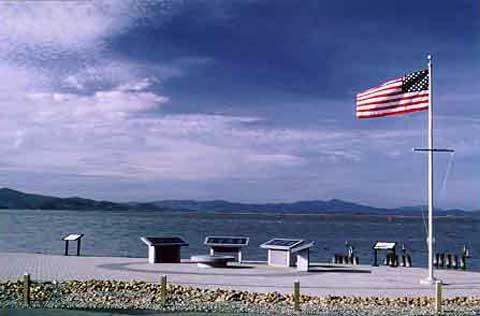It's a long way from the big city with the same name, and the park's history may not be familiar to many Americans, but Port Chicago Naval Magazine National Memorial has a compelling story, and it's now the newest addition to the National Park System.
Port Chicago Naval Magazine is located not far from San Francisco, and until the summer of 1944 it was merely one of many military sites supporting operations during World War II. That situation changed dramatically on July 17, 1944. Information from the park summarizes the story:
Crews at the magazine in the San Francisco Bay area were loading two Pacific-bound naval vessels with active munitions when the explosives ignited in a terrific series of blasts. Felt throughout the area, the explosions broke windows as far away as San Francisco, hurled debris in the air, obliterated both ships, and killed everyone at the waterfront. To this day, because of the tragedy, ignition sources for bombs and guns are loaded separately on carriers.
The disaster caused the greatest loss of life on the home front during World War II. 320 men died, and almost 400 others were injured. Of the 320 killed, 202 were African Americans.
In the nation’s then-segregated military, enlisted and drafted African Americans could work in kitchens, cooking meals for fellow servicemen, or as stevedores, loading and unloading ships. The stevedores at Port Chicago lacked training and thought they were handling inactive munitions. In reality, they were working at top speed to load bombs equipped with warheads.
Perhaps the greatest impact of this tragedy was not the terrible loss of life, but the legal, political and social implications of the events that followed.
After the explosion, African American survivors were sent to a nearby base to resume loading ships for the war effort. Many refused to continue their work without safety training, and the U.S. Navy charged 50 of these men with “conspiring to make mutiny.” They were tried, convicted, and imprisoned.
After the war, they were released, granted clemency, allowed to complete their military service, and given honorable discharges. Only one was ever pardoned.
Thurgood Marshall, Chief Consul for the National Association for the Advancement of Colored People (NAACP), attended the trial and took advantage of the occasion it presented to speak with journalists several times about racial discrimination in the armed forces.
A comment on the park website offers a good summary of the long term importance of this incident:
Though a sad story, several positive things came from these events.
First, the navy began desegregating its units in June of 1945. Then on July 26, 1948, President Truman signed Executive Order 9981 calling for the desegregation of the Armed Services. A couple of baby steps towards civil rights in this country, but big ones.
It was also realized that certification would have to be required for the handling of munitions, and that all munitions be re-designed for safety.
The Port Chicago site had been previously designated as an affiliated area: a place whose national importance is recognized but where no federal money is spent on education, historic preservation, or efforts to increase public awareness of the site’s significance.
The Defense Authorization Act, which was signed this week by President Obama, calls for the transfer to the National Park Service of the five acres around the site of the 1944 explosion; for the National Park Service and the military to coordinate public access through an active military base; and for the establishment of a visitor orientation facility with curatorial storage in concert with the City of Concord and the East Bay Regional Parks District.
National Park Service Director Jonathan B. Jarvis said,
“The addition of Port Chicago demonstrates a commitment to make America’s best idea even better—more relevant to Americans, more expressive of our nation’s history, and more representative of our diversity."
“We’re honored to provide educational opportunities and preservation at Port Chicago,” Jarvis continued. “We have a chance, as the National Park Service heads to its centennial in 2016, to reach out to Americans with places that hold meaning for them and make all of us culturally aware. Port Chicago is one of those places."
Martha Lee is superintendent of the new site, and of Rosie the Riveter World War II Home Front National Historical Park, John Muir National Historic Site, and Eugene O’Neill National Historic Site. She noted,
“We are committed, along with our partners—the Army, the Friends of Port Chicago, the City of Concord, and the East Bay Regional Park District—to preserving this site, which has such a rich history."
The ocean-side memorial currently features bunkers, boxcars, and remnants of piers, as well as interpretive signage and a granite monument bearing the names of those who died in the explosion. If you want to visit the area, you'll need to plan ahead, because the site is located within an active military base where munitions are still being handled. That raises security and safety concerns that require advance approval for a visit.
Reservations for visiting Port Chicago Naval Magazine National Memorial can be made by calling 925-228-8860. Visitors should call at least two weeks in advance. They need military clearance as well as reservations. No visits occur when the docking and loading of military ships are planned.
The park website includes additional details about arranging a visit, directions to the park, and more information about the park story.




Comments
Beautiful page on Pt. Chicago Naval Magazine National Memorial. Thank you.